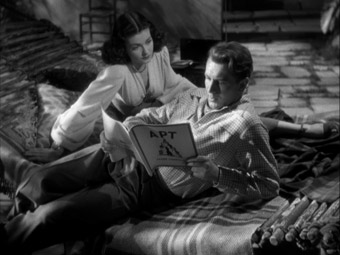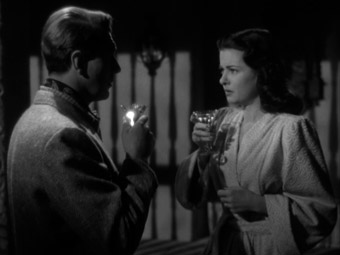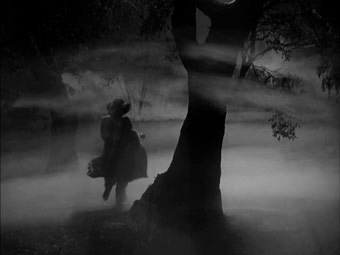|
Film titles can sometimes be so important. Take the 1947 Secret Beyond the Door, which for the first twenty minutes plays more like a romantic drama than the suspense story into which it later develops, so much so that if you came for the thrills then you'd initially be forgiven for thinking you'd bought a ticket for the wrong film. Hence the importance of the title, one not so specific to act as a spoiler but suggestive enough to assure us that a mystery will unfold if we just keep our seats.
The scene is set with the sort of economy and speed that even current in-a-hurry American cinema would struggle to match. Central to the story is Celia Barrett (Joan Bennett), who in the opening sequence is standing in her bridal dress about to be married and looking just a little apprehensive about the whole thing. In the blink of an edit we've jumped back in time to tell the story of how we arrived at this moment, which convention suggests may take most of the film. It doesn't. Not by a long chalk. We're quickly introduced to Celia's good natured brother Rick (Paul Cavanagh), fresh-faced young lawyer Bob (James Seay), Celia's financial stability and Rick's failing health. A couple of minutes later we've hopped forward a year and Rick has has passed away. The caring, reliable and rather dull Rob now dotes on Celia and wants them to wed. Celia's certainly giving it some thought, but before making a decision she nips off with her close friend Edith (Natalie Schafer) to Mexico for one last fling, where she meets and falls for handsome architect and magazine publisher Mark Lamphere (Michael Redgrave). After a whirlwind romance, the two fall head-over-heels in love and decide to marry, and we're back at the wedding ceremony with the apprehensive Celia's as she wrestles with her uncertainty about the rapidity of her decision. Total flashback screen time: ten and a half minutes. And get this, it never feels hurried. This, my friends, is economical filmmaking.

Aside from Celia's doubts, some wonderfully suggestive lighting camerawork (more on this in a minute), and Celia's curious fascination with a Mexican knife-fight, there is nothing here to suggest this will be anything other than a relationship drama. Celia and Mark are both clearly smitten, and with Mark's income from publishing and Celia's trust fund they are financially secure. Mark even has a big country house in which they can live. What could possibly interfere with their future happiness?
The first fly in the ointment comes when Celia arrives at Mark's home and is informed by his sister Caroline (Anne Revere) of the existence of David (Mark Dennis), Mark's son by a previous marriage that Celia was previously unaware of. It's also here that she meets the frosty Miss Robey (Barbara O'Neil), who keeps part of her face covered to hide the scars left by a fire. All of this understandably troubles Celia, but her concerns are repeatedly diffused by Mark's clear explanations and his very real devotion to her. It's only after a party, when Mark reveals the dark side of his unusual hobby, that Celia begins to really suspect that not all is as it should be.
Ah yes, Mark's hobby. This, for me, was one of the highlights of the film's busy bank of interesting ideas. Mark's passion for architecture extends to the intriguing theory that the design and décor of a room can directly affect the behaviour of its occupants. To this end he has begun a collection, not of interior designs but of rooms themselves, which he's had deconstructed and re-assembled in a wing of his sizeable house. And these are not just any rooms, no sir. Each of them was the scene of a crime in which at least one of its occupants came to an unpleasant end, and have been preserved as they were when the bodies were first discovered. Can you see why Celia might be getting the jitters? What really worries Celia is room number 7, which Mark keeps locked and declines to show to his guests, even though its construction is apparently complete.

Made midway through his American period, Secret Beyond the Door impressively showcases Fritz Lang's skills as noir thriller director, with even the couple's early happiness is subtly undercut by the suggestive games played with light and shadow. Lang is aided immeasurably here by cinematographer Stanley Cortez, who is close to his imposing Night of the Hunter best, adding an undercurrent of unease to seeming innocuous encounters. As Mark approaches Celia on the day of her wedding, for example, his face is initially cast into shadow, a technique re-employed later in a conversation between the two and a reflection of how little Celia really knows about the man she is marrying. This noir-influenced approach to lighting really comes into its own when Celia starts exploring the house corridors at night, heightening the sense that just anything could be waiting in the shadows and hitting a creative peak when she flees into the garden, where the dark beauty of the imagery is genuinely breathtaking (how, one wonders, did Cortez and his team arrange for slivers of mist to float motionless in the air and be disrupted only when Celia runs through them?). I was initially less certain about the decision to punctuate the action with Celia's voiced thoughts, which while poetically written by Silvia Richards and in-keeping with the film's noir sensibilities, intermittently stall the otherwise brisk storytelling to allow the sometimes motionless Celia to reflects on things that are evident without this vocal accompaniment. It does ease off as the film progresses, and its self-analytical nature ties in well with the film's strong Freudian overtones.
Adapted from Rufus King's short story Museum Piece No. 13, Secret Beyond the Door is an update of Charles Perrault's Bluebeard by way of Hitchcock's Rebecca. It provides a choice role for Joan Bennett (that it was executive produced by her husband Walter Wanger is neither here nor there) and gave the splendid Michael Redgrave his first American film role, having been cast on the strength of his performance as the unhinged ventriloquist in Dead of Night. Redgrave's controlled restraint is crucial to selling both Mark's love for Celia and his psychological issues without tipping the thunderstorm-accompanied final act into full-blown melodrama. Late in the story he even inherits Celia's thoughts voice-over, imagining a court case for a crime that he may or may not have committed in which he is both defendant and prosecutor, cross-examining himself and at one point delivering his response directly to camera.

It seems genuinely astonishing that Secret Beyond the Door had both a troubled production and an initially hostile critical reception, though its reputation has subsequently soared and is now widely regarded as one of the best films of Lang's mid-American period. Despite the familiarity of the basic setup – in movies at least, women who marry men whose past they know little about are generally walking into trouble – the film successfully keeps us guessing and the characters do not always follow the expected paths. Richly atmospheric, genuinely suspenseful (the fact that Lang is able to wring tension from unbroken wide shots where anyone else would plump for a close-up almost defies film logic), and boasting a rich score by Miklós Rózsa and a surreal opening title sequence created by the Disney studio, Secret Beyond the Door is a captivating melding of film noir thriller and psychological drama, one that you can't help suspecting that Freud himself would have had a field day with if he could have got it on his couch.
The transfers on recent Exposure Fritz Lang releases have varied in quality somewhat, from the serviceable job done on While the City Sleeps to the source print condition and standards conversion issues on Beyond a Reasonable Doubt. Secret Beyond the Door makes its UK DVD debut here in what we are assured is remastered form. Call me cynical, but I've come to distrust that term, having seen it applied to everything from the pristine to the shockingly shabby. Happily, the transfer here is far closer to the former than the latter, boasting a crisply detailed picture with spot-on contrast and rich, deep blacks, an essential element of any film noir. There are still a few dust spots here and there, but for the most part the picture is impressively clean and free of damage. It's also an authentic PAL transfer rather than a standards conversion. A very nice job.

The Dolby 2.0 mono soundtrack is in similarly good shape. Its tonal range is slightly broader that you might expect for a film of this vintage, the dialogue and music are clear and distortion free, and you have to really crank up the sound to hear even a trace of background hiss.
English subtitles for the hearing impaired are also provided.
There are three rolling Stills Galleries set to music lifted directly from the film (the odd sound effect gives this away): Posters and Lobby Cards (1:27), Publicity Stills (3:26) and Behind the Scenes (1:07). All are a good size (close to full screen in most cases) and the best are of excellent quality.
Filmographies are provided for director Fritz Lang and actors Joan Bennett, Michael Redgrave, Anne Revere and Barbara O'Neil.
Not on the disc but included in the case is a slim but still impressive Booklet, which includes three short but worthwhile articles – an appreciation of the film by critic and author David Hughes, a piece on Hollywood and Freud by critic and historian James Oliver, and a look at Lang's career in Hollywood by writer Claudette Pyne. Taking their cue from Masters of Cinema, Exposure have also includes stills, film credits, a reproduction of the poster, and advice on how to correctly view the film on a widescreen TV.
Secret Beyond the Door is American-era Fritz Lang on impressive form, a gorgeously shot and compellingly performed Freudian Bluebeard update, and a small hymn to the joys of monochrome noir. Exposure have done really well by the film here, with an impressive restored transfer and a small but well targeted collection of extras (the booklet is especially welcome). Recommended.
|